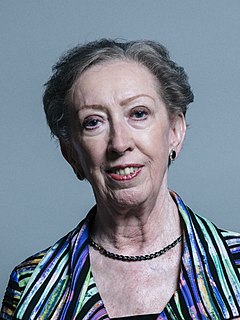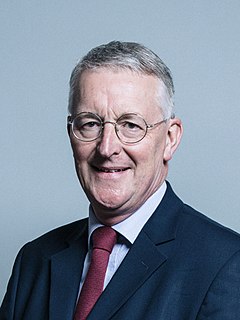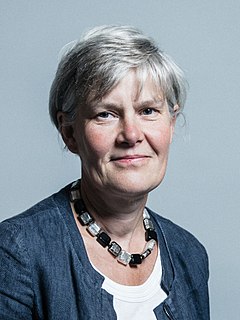
Dame Margaret Mary Beckett is a British Labour Party politician who has been the Member of Parliament (MP) for Derby South since 1983. She was the Deputy Leader of the Labour Party under John Smith from 1992 to 1994, and briefly served as Leader of the Labour Party after Smith died suddenly. She later served in the Cabinet under Prime Minister Tony Blair in a number of roles, becoming Britain's first female Foreign Secretary in 2006.

Hilary James Wedgwood Benn is a British Labour Party politician who has been the Member of Parliament (MP) for Leeds Central since the by-election in 1999. He served in the cabinet from 2003 to 2010, under the premierships of both Tony Blair and Gordon Brown. From 2010 to 2016, he served in various Labour Party shadow cabinets, most recently as Shadow Foreign Secretary from May 2015 until June 2016, when he was dismissed by Labour leader Jeremy Corbyn. In October 2016, he was elected as the Chairman of the new Exiting the European Union Select Committee.

Harriet Ruth Harman is a British solicitor and Labour Party politician who has served as a Member of Parliament since 1982, first for Peckham, and then for its successor constituency of Camberwell and Peckham since 1997. She has served in various Cabinet and Shadow Cabinet positions and, in her role as Deputy Leader of the Labour Party, she has served as the acting Leader of the Labour Party and Leader of the Opposition twice: from May to September 2010 and from May to September 2015.

Stephen Twigg is a British Labour and Co-operative Party politician who has been Member of Parliament (MP) for Liverpool West Derby since 2010. He previously served as the Member of Parliament for Enfield Southgate from 1997 to 2005.

Angela Eagle is a British Labour Party politician who has been the Member of Parliament (MP) for Wallasey since the 1992 general election. Eagle was born in Yorkshire and studied PPE at the University of Oxford, before working for the CBI and then a trade union.

Maria Eagle is a British Labour Party politician, Member of Parliament for Garston and Halewood and former Shadow Secretary of State for Culture, Media and Sport.

Katherine Anne Green is a Labour Party politician who was first elected as the Member of Parliament (MP) for Stretford and Urmston in 2010.
The Commons members of the Parliamentary Labour Party (PLP) elected 19 members of the Shadow Cabinet from among their number in 2010. This follows the Labour Party's defeat in the 2010 general election, after which the party formed the Official Opposition in the United Kingdom.
Elections to the Labour Party's Shadow Cabinet took place in July 1992. Shadow Cabinet elections generally take place at the beginning of a parliamentary session, but the 1992 vote was postponed until a new leader was elected to replace Neil Kinnock. Under the rules then in effect, the Commons members of the Parliamentary Labour Party elected 18 members of the Official Opposition Shadow Cabinet, who were then assigned portfolios by the leader. The Commons members of the PLP separately elected the Chief Whip, and the Labour peers elected the Leader of the Opposition in the House of Lords. In addition, the Leader of the Labour Party and Deputy Leader were members by virtue of those offices. The 18 elected members of the Shadow Cabinet were the ones with the largest number of votes, except that the three women with the most votes would be included in the 18, even if they weren't among the top 18 based on the number of votes.
Elections to the Labour Party's Shadow Cabinet took place in October 1993, at the beginning of the 1993/4 session of parliament. Under the rules then in effect, the Commons members of the Parliamentary Labour Party elected 18 members of the Official Opposition Shadow Cabinet, who were then assigned portfolios by the leader. The Commons members of the PLP separately elected the Chief Whip, and the Labour peers elected the Leader of the Opposition in the House of Lords. In addition, the Leader of the Labour Party and Deputy Leader were members by virtue of those offices. The 18 elected members of the Shadow Cabinet were the ones with the largest number of votes. Beginning with this election, MPs were required to vote for at least four women, but women were no longer guaranteed three places in the Shadow Cabinet.
Elections to the Labour Party's Shadow Cabinet took place in October 1994, at the beginning of the 1994/5 session of parliament. Under the rules then in effect, the Commons members of the Parliamentary Labour Party elected 18 members of the Official Opposition Shadow Cabinet, who were then assigned portfolios by the leader. The Commons members of the PLP separately elected the Chief Whip, and the Labour peers elected the Leader of the Opposition in the House of Lords. In addition, the Leader of the Labour Party and Deputy Leader were members by virtue of those offices. The 18 elected members of the Shadow Cabinet were the ones with the largest number of votes. MPs were required to vote for at least four women, but women were not necessarily guaranteed places in the Shadow Cabinet.
Elections to the Labour Party's Shadow Cabinet took place in October 1995, at the beginning of the 1995/6 session of parliament. Under the rules then in effect, the Commons members of the Parliamentary Labour Party elected 19 members of the Official Opposition Shadow Cabinet, who were then assigned portfolios by the leader. The Labour peers elected the Leader of the Opposition in the House of Lords. In addition, the Leader of the Labour Party and Deputy Leader were members by virtue of those offices. With this election, for the first time, the role Opposition Chief Whip was simply another portfolio to be handed out rather than an office separately elected by the PLP. The 19 elected members of the Shadow Cabinet were the ones with the largest number of votes. MPs were required to vote for at least four women, but women were not necessarily guaranteed places in the Shadow Cabinet.
Elections to the Labour Party's Shadow Cabinet took place in July 1996. Under the rules then in effect, the Commons members of the Parliamentary Labour Party elected 19 members of the Official Opposition Shadow Cabinet, who were then assigned portfolios by the leader. The Labour peers elected the Leader of the Opposition in the House of Lords. In addition, the Leader of the Labour Party and Deputy Leader were members by virtue of those offices. The 19 elected members of the Shadow Cabinet were the ones with the largest number of votes. MPs were required to vote for at least four women, but women were not necessarily guaranteed places in the Shadow Cabinet.

Ed Miliband became Leader of the Labour Party and Leader of the Opposition upon being elected to the former post on 25 September 2010. The election was triggered by Gordon Brown's resignation following the party's fall from power at the 2010 general election, which yielded a Conservative – Liberal Democrat Coalition. Miliband appointed his first Shadow Cabinet in October 2010, following the Labour Party's Shadow Cabinet elections. These elections were the last such elections before they were abolished in 2011.

John Smith was Leader of the Labour Party and Leader of the Official Opposition from 18 July 1992 until his death on 12 May 1994. Smith became leader upon succeeding Neil Kinnock, who had resigned following the 1992 general election—for the fourth successive time, the Conservatives had won and Labour lost.

Tony Blair, as Leader of the Labour Party, was Leader of the Opposition in the United Kingdom from his election as Leader on 21 July 1994 until he became Prime Minister on 2 May 1997. He announced his first Shadow Cabinet on 20 October 1994.

Neil Kinnock was Leader of the Labour Party and Leader of the Opposition from 2 October 1983 to 18 July 1992. He convincingly defeated Roy Hattersley, Eric Heffer, and Peter Shore in the 1983 leadership election, which was prompted by Michael Foot's resignation following the disastrous general election result earlier that year. Kinnock's period as Leader encompassed the bulk of the Thatcher years and the first two years of Major premiership. Kinnock resigned in 1992 after losing his second election as Leader.
Jeremy Corbyn assumed the position of Leader of the Opposition after being elected as Leader of the Labour Party on 12 September 2015; the election was triggered by Ed Miliband's resignation following the Labour Party's electoral defeat at the 2015 general election when David Cameron formed a majority Conservative government.

The 2016 Labour Party leadership election was called when a challenge to Jeremy Corbyn as Leader of the Labour Party arose following criticism of his approach to the Remain campaign in the referendum on membership of the European Union and questions about his leadership of the party.
Elections to the Labour Party's Shadow Cabinet took place on 23 October 1991. Under the rules then in effect, the Commons members of the Parliamentary Labour Party elected 18 members of the Official Opposition Shadow Cabinet, who were then assigned portfolios by the leader. The Commons members of the PLP separately elected the Chief Whip, and the Labour peers elected the Leader of the Opposition in the House of Lords. In addition, the Leader of the Labour Party and Deputy Leader were members by virtue of those offices.












